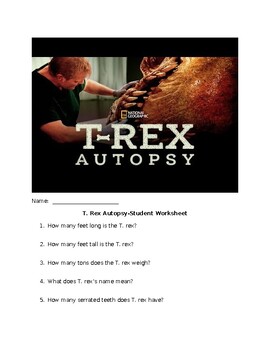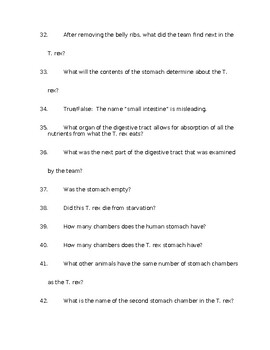T. rex Autopsy Worksheet for National Geographic Video
- Word Document File
Description
T. Rex Autopsy is a 2015 documentary airing on the National Geographic channel where a team of four paleontologists dissect a silicon replica of Tyrannosaurus. The four paleontologists were Tori Herridge, Stephen Brusatte, Matthew T. Mossbrucker and Luke Gamble, who is the lead anatomist. The T. rex was based on the most complete fossil, "Sue."
This once-in-a-lifetime experiment offers an unprecedented opportunity to explore questions such as whether or not T. rex had feathers; how it fed with tiny arms; whether it was primarily a hunter or scavenger; how it digested food; how old it lived to be; how it procreated; and whether it was warm-blooded like a mammal or cold-blooded like a reptile.
With eyes the size of grapefruits, 30 centimetre-long teeth and a stomach big enough to digest a four-year-old child, the T. rex is lifelike inside and out. Using cutting-edge special effects techniques and in collaboration with esteemed veterinary surgeons, anatomists, and paleontologists, T. rex Autopsy illuminates the latest research and findings about Tyrannosaurus rex.
This is a great activity to do with Earth & Space Science, Human Anatomy & Physiology, Zoology I, Zoology II, Biology, and General Science. It gives students the opportunity to apply concepts learned from class (prehistoric life, dinosaurs, skeletal system, muscular system, cardiovascular system, digestive system, animal behavior, parasitic infection) while watching a movie with great visual effects.
Movie Running Time: 1 hour, 27 minutes, and 42 seconds
Video Link: National Geographic T-rex Autopsy - YouTube





